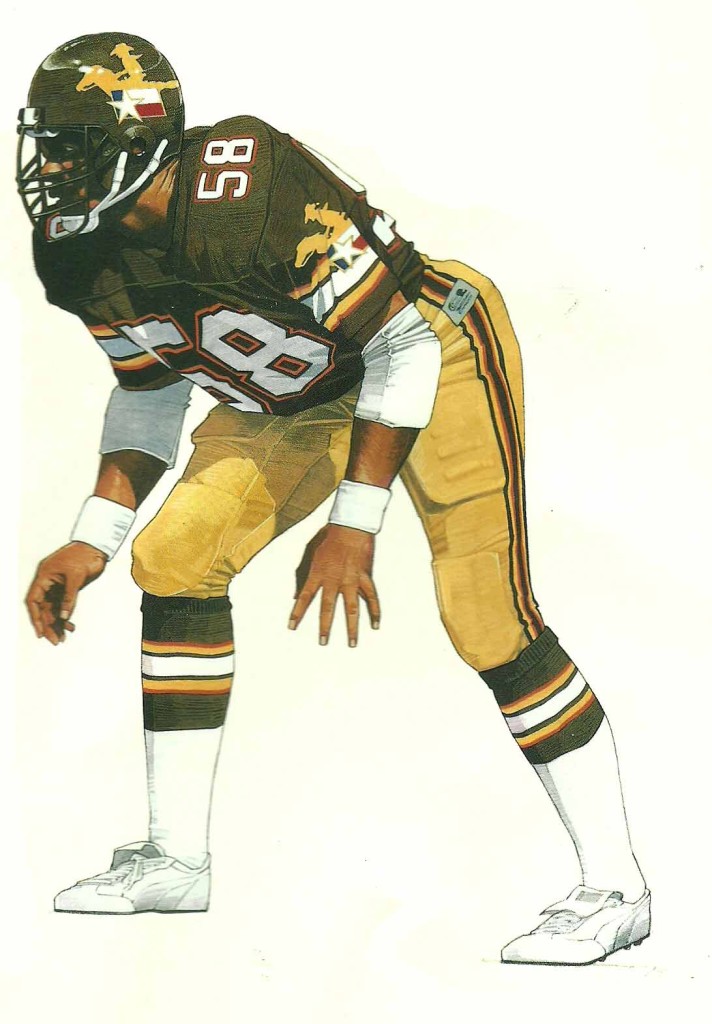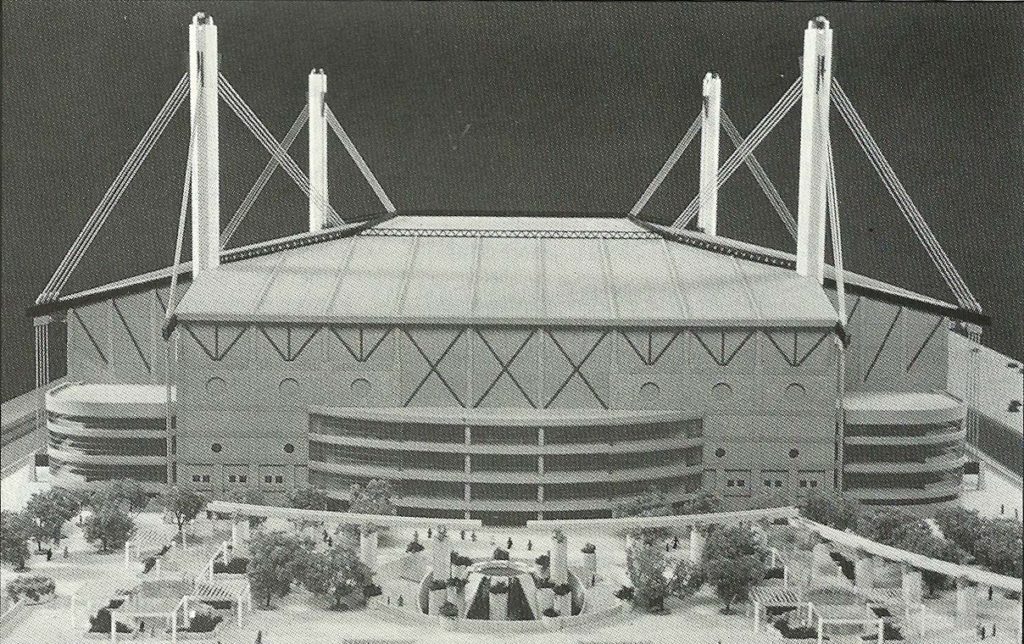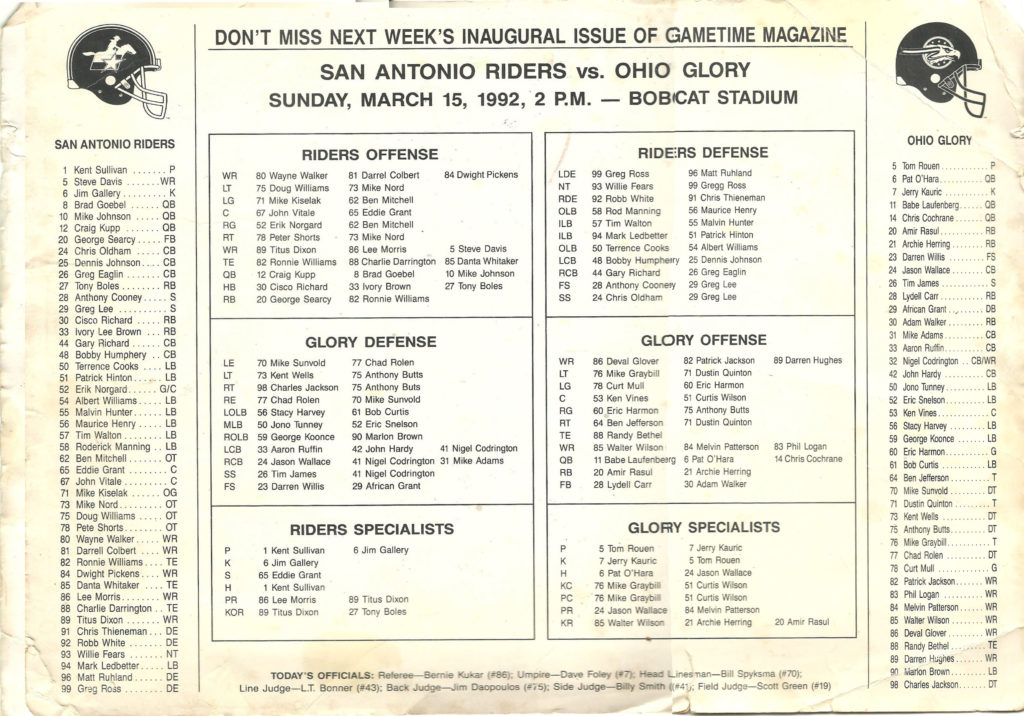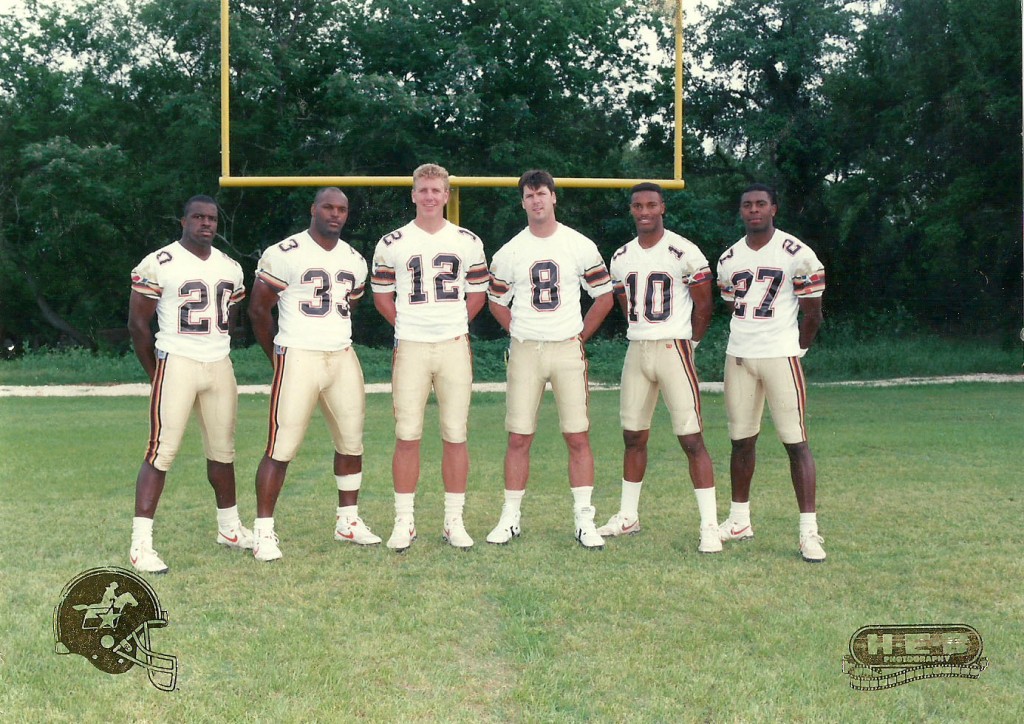
Coach: Mike Riley
Stadium: Alamo Stadium (1991), Bobcat Stadium (1992)
Record: 4-6 (1991), 7-3 (1992)

BACKGROUND:
The San Antonio Riders were one of the founding franchises of the WLAF in 1991. In April of that year, Larry Benson (brother of New Orleans Saints owner Tom Benson) won the bidding war over Gavin Maloof for the right to the San Antonio market. Benson became the majority owner over a small syndicate of owners, that chose the name ‘Riders’ – over such contenders such as: ‘The Alamo’, ‘Lone Stars’ and ‘Trail Riders’.

The Riders were managed by Dallas Cowboys coaching great Tom Landry. In 1991, the Riders played in dilapidated Alamo Stadium in San Antonio. The turf was aging and so bad that the broadcast crew would talk about it during the game. An argument over beer sales ensued with the school district after the season, and soon thereafter the district jacked up the rent, so the team opted to move its games up the road to tiny San Marcos/ Bobcat Stadium. With the relocation for 1992 completed this placed the Riders roughly halfway between Austin and San Antonio on the I-35 corridor. The team hoped that once the Alamodome was completed in San Antonio, the Riders would be able to relocate back there as early as 1993.

The San Antonio Riders were coached by Mike Riley, a Bear Bryant disciple and former defensive back at Alabama. Riley had been successful at the college level and also at the CFL. Hungry to make a puddle jump to the NFL, Mike made the transition to the WLAF and assembled his team.
Riley’s offenses were typical of ball control offenses of the time, however it most resembled the Washington Redskins system, sporting 3 wide receivers and a single back, utilizing play-action, traps, and bootlegs. For the most part the team relied on a strong ground game supported by a tough defense.

1991:
The Riders were led intially by quarterback Jason Garrett, but injuries yielded him to Lee Saltz. The Riders scoured Team Dallas and located his backup, Mike Johnson. Johnson then replaced Saltz after he too got injured. Mike ended up starting the majority of the wins for the Riders that season. On the offensive line, the team featured future CFL All Star Mike Kiselak, and future wrestler John Layfield. James Harper was considered the best all around blocking prospect. John Garrett, Billy Hess, Dwight Pickens, and Lee Morris would head up an all around underrated wide receiver corps. The offensive engine of the team was Ricky Blake, a bruising powerback who was assisted by Broderick Graves and Undra Johnson. As the team got more comfortable with its identity, Ronnie Williams became a key cog at TE. A hybrid blocker with great size, hands, and speed. The Riders liked to line him up wide to expose mismatches.
The defense was led by All-World linebacker Tim Walton, and second team All-World players Mark Ledbetter and Donnie Gardner. San Antonio’s defense was considered quite stubborn. They gave up very few yards receiving and played havoc with QBs completion percentage.
San Antonio’s first game was a fireworks show against the spread offense Orlando Thunder, full of big plays and high scoring. There was no defense really by either team, and the 35-34 game would be the league’s highest scoring output of the season. Orlando quarterback Kerwin Bell threw 3 touchdown passes to Byron Williams to pace the Thunder towards their victory, but when Teddy Garcia missed an extra point for San Antonio, this would provide to be the difference in the game. The helmet camera was used by Kerwin Bell for the contest, and it was carried on USA Network.
The Riders were in the hunt for the playoffs in 1991 up until the final week, needing a little help. SA had a 3 game losing streak in the middle of their schedule, which really killed them. They rebounded late to knock of Montreal in convincing fashion in Week 9, but needed help to win, as the Fire held the head to head tie breaker over the Riders. It ended up not mattering as the Riders dropped their season finale to the Knights anyway.
1992:


The Riders during the 1992 season preserved some of their original roster, while tweaking it out with some NFL veteran presence. They were allowed to pick the rosters of the San Diego Chargers, Denver Broncos, Dallas Cowboys, and the New Orleans Saints for loaners.
The biggest void the team had to fill was almost its complete running back stable. To solve this problem the team grabbed Ivory Lee Brown (Arizona Cardinal allocation) and Tony Boles, (-a Dallas Cowboys castoff who was trying to resurrect his career after drug and law problems) for a change of pace. Stump Mitchell was also brought in as part of the NFL Minority Coaches Fellowship to help coach the running backs. Boles and Brown both got off to fast starts, but by week 3 Boles was AWOL, so Brown had to share the load with mainly George Searcy. Cisco Richard was added late in the season and added an impressive wrinkle in the offense. This did not stop the Riders from crushing people on the ground as Brown would finish first in rushing in 1992.
Mike Johnson at quarterback got no respect despite commandeering wins for the team. The Eagles loaned fan favorite Brad Goebel from Baylor to the Riders and he gave Johnson stiff competition.
Underrated Ronnie Williams at tight end would lead all players from that position with 35 receptions. The Riders sported a variety of All-World players in 1992. Center John Vitale would be named to the 1st team, as well as Ivory Lee Brown at runningback.
Jim Gallery turned in a great 1992 season while Teddy Garcia went on to kick for the Dragons.
Bobby Humphery, provided a mainstay veteran presence in the secondary after playing for the Jets and Rams in the NFL. On defense Chris Theinemen and Dick Chapura were both be named on the line to the All-World Team. Consistent Tim Walton also made it again as well at linebacker. The team finished with 32 sacks and 10 picks (2 tds) and were especially stout against the run.
There were quite a few memorable games for the Riders during the 1992 season. Three come to mind immediately.
First was the San Antonio versus Ohio matchup in Week 6 or 7. The Riders kept the heat on Pat O’Hara all game, but the best part was when a freak hailstorm/ monsoon rolled up right before halftime and interrupted play. We then got a free, impromptu halftime show from a very excited fan who ran across the field. The delay didn’t stop the Riders from drubbing the Glory 17-0, as San Antonio’s smothering defense was on full display. Gary Richard had his finest moment as a pro intercepting a pass and returning it for a TD.
In Week 4 of the season the Riders played one of the most exciting and competitive games in WLAF history for a second time, but this time came out on top, defeating the Sacramento Surge in OT 23-20. QB Mike Johnson set team records as he threw for 250 yards on 25/40 passes, without being intercepted, while completing at one point a stretch of 8 passes in a row. The Riders were down 13-0 before the half and 20-10 with 9:44 left in the 4th quarter. They were able to get the ball back with less than a minute, drove down the field and kicked a field goal to tie the game 20-20. Jim Gallery kicked his 3rd field goal of the night, and the Surge responded by driving down the field. Surge receiver Eddie Brown caught a pass but as he made a football move with the ball he was stripped by CB Bobby Humphery who sealed the win for the Riders.
The last game in the history of the franchise was the rematch do or die contest as the Riders against the Surge. It was disappointing to see SA lose 24-20 at home, but the largest crowd of the season showed up with a near 20,000 in attendance. Despite the Riders 7-3 record, they finished 3rd in their division and out of the playoff hunt.
What was even more frustrating that the NFL got impatient with the WLAF and suspended operations after the 1992 season never to play in North America again. The Riders pegged their total losses for 2 years at roughly $750,000 which wasn’t much, although the franchise was highly subsidized by the NFL.

NOTES:
The Riders established two rivals during that initial season- the Sacramento Surge and the Birmingham Fire. Sacramento as mentioned previously had a storied and exciting rivalry with the Riders and couldn’t be any more dissimilar. Birmingham and San Antonio however were very close philosophically and both teams were built on scrappy defenses and solid run games. This made them natural rivalries. The Riders played a 12-16 yawner of a loss to the Fire where the team was unable to punch the ball into the endzone in 1991. In 1992, the Riders lost to the Fire early on 17-10 then beat them 17-14 later in that season. Birmingham also sitting at 7-2-1 made the playoffs as a Wild Card in 1992 while the Riders sat at home.

My father and I attended all the Riders home games in 1992 (and the preseason game against the Glory before the season). For that first preseason game the team installed bleachers in the endzones for additional fans. Fans were extremely hostile towards Babe Laufenberg of the Glory, since he had just played in the previous season for the Cowboys. The Riders kept constant pressure in his face all day during the scrimmage and he was miserable. The game would serve as a tie breaker if the two teams were to finish with the same record after the season. -Unfortunately neither team would need it.
Bobcat Stadium had no box seating, so Larry Benson and Tom Landry were easily accessible by fans as they sat in the shade underneath the bleachers. In general, security was minimal and you could walk down on the field during warmups and on the field during halftime to ask for autographs. I’d talk to Mike Riley after the game about what they were trying to do and take photos with the players and team. (It obviously was a different time back then.)


LEGACY:
In 1993, San Antonio would not be without a team for long as Benson immediately signed up for the CFL unveiling the team as the San Antonio Texans in front of the still half finished Alamodome. (The colors were inspired by the Texas flag and had a silver helmet, which in the end felt like the illegitimate step-son of the Cowboys and Oilers.) Mike Riley was also named head coach. The Texans though never took the field as a CFL team- folding before the season even begun under financial strain.
Going without a team for another season, the Sacramento Goldminers, (formerly the Surge) moved to San Antonio taking the field with virtually the same staff and owner re-dubbed as the San Antonio Texans in 1995. Despite having now a field that could accommodate the CFL game in the Alamodome and decent attendance, the Texans, Riders, and Surge finally died after that season- as the CFL decided to fold the remaining USA franchises.
Although many minor leagues and the Arena Football league have tried to get football off the ground in San Antonio, it wasn’t until 2019 when the Alliance of American Football hit the field that SA had another team to call their own as the Commanders led the league in attendance. In the greatest stroke of irony, Mike Riley took the stage as head coach, and brought Riders alum Bill Bradley, and Ken Watson along with him. The Commanders finished 5-3, as the league unfortunately folded under financial duress- again leaving SA as the eternal lady in waiting for a professional football franchise.

HC- Mike Riley
Other Coaches- Bill Bradley, Stump Mitchell, Paul Chryst
QB- Jason Garrett, Mike Johnson, Bobby McAllister, Brad Goebel
RB- Ricky Blake, Undra Johnson, Ivory Lee Brown
FB- George Searcy
OL- Eric Norgard, Mike Kiselak , Doug Williams
TE- Ronnie Williams
WR- Bill Hess, John Garrett, Dwight Pickens, Darrell Colbert, Wayne Walker, Titus Dixon, Lee Morris
DL- Willie Fears, Robb White
LB- Greg Gilbert, Mark Ledbetter, Tim Walton,
DB- Ken Watson, Gary Richard, Bobby Humphery, Greg Eaglin
P- Kent Sullivan




At this time I am still missing autographs on these cards from:

Pro Set WLAF 1991:
Donnie Gardner
John Layfield
Wild Card WLAF 1992:
Tony Boles
Titus Dixon
Terrence Cooks
Teddy Garcia
Cisco Richard
Ultimate 1992:
Jim Gallery
Broderick Graves
Greg Lee
